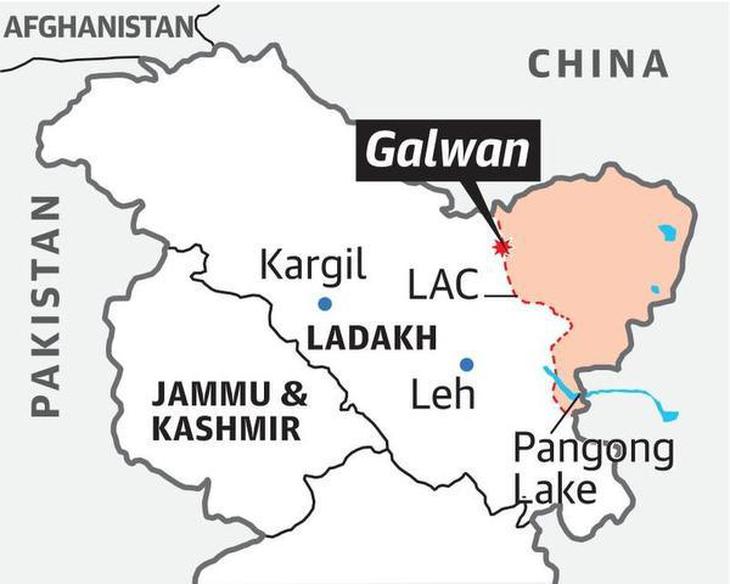Table of Contents
Context
The Galwan clash of June 15-16, 2020 marked a watershed in India-China ties, which were already tense after the Chinese in April intruded into several places in Eastern Ladakh that are claimed by India. The deaths of 20 soldiers in Galwan was the first time Indian Army personnel were killed on the Line of Actual Control after October 1975, when four Assam Rifles men died in a Chinese ambush at Tulung La in Arunachal Pradesh.
Location of Galwan Valley
The Galwan Valley refers to the land that sits between steep mountains that buffet the Galwan River. The river has its source in Aksai Chin, on China’s side of the LAC, and it flows from the east to Ladakh, where it meets the Shyok River on India’s side of the LAC. The valley is strategically located between Ladakh in the west and Aksai Chin in the east, which is currently controlled by China as part of its Xinjiang Uyghur Autonomous Region. At its western end are the Shyok River and the Darbuk-Shyok-Daulet Beg Oldie (DSDBO) road. Its eastern mouth lies not far from China’s vital Xinjiang Tibet road, now called the G219 highway.

Significance of Galwan clash
According to the 1993 Border Peace and Tranquility Agreement (BPTA) , India and China agreed to “strictly respect and observe the LAC between the two sides”. This referred to the LAC at the time, rendering irrelevant the line of actual control in 1959 or 1962. It also says that “when necessary, the two sides shall jointly check and determine the segments of the line of actual control where they have different views as to its alignment.” Clarifying the LAC has also been explicitly codified in the 1996 agreement on confidence-building measures and subsequent agreements. China, however, has refused to exchange maps in the Western sector to take this process forward. The BPTA also said “The two sides agree that references to the line of actual control in this agreement do not prejudice their respective positions on the boundary question.
The LAC(Line of actual control) refers to territory under the effective control of each side, not to their entire territorial claim. For instance, India’s territorial claims extend 38,000 sq km on the other side of the LAC across all of Aksai Chin, but the LAC India observes runs through the valley. It is true that the LAC has never been demarcated and there are differences in perception of where it lies in more than a dozen spots, but there have not been previous incidents in the valley.
India-China relations post Galwan
- Economic: There has also been an effort to reduce India’s dependence on Chinese goods. The government has mandated all products to have the Country of Origin tag for products on the Government e-Marketplace in an effort to identify Chinese-origin goods. Ministry of Power restricted power supply systems and networks imported from China citing cyber and security threats, which constitute about 30% of the total imports from China. India has kept Huawei Technologies Co. out of 5G trials, and outlawed more than 270 Chinese apps, causing technology companies to withdraw from the country.
- Infrastructure: The last three years have seen a massive push towards infrastructure development which includes the creation of military posts, living habitats and gun positions, apart from new roads, bridges, tracks, tunnels, and helipads. Border Roads Organisation (BRO) completed 19 infrastructure projects in 2021 and 26 in 2022 in Ladakh alone. It has set a target of completing 54 projects this year. These include roads and bridges among other miscellaneous projects. Key infrastructure projects include the construction of an alternate route to Daulat Beg Oldie, Saser-Brangza bridge, the Shinku La tunnel linking the pass connecting Himachal Pradesh with Ladakh, Roads connecting Khalste to Batalik, Kargil to Dumgil and Khalsar to Shyok and Tangtse to Lukung and a tunnel at Hambotingla.
- Strategic: Galwan clash has led to a deepening of cooperation between India and China. India joined the US-led Indo-Pacific Economic Framework (IPEF), which aims to counter China’s influence in the region. Apart from India’s elevation of QUAD to the summit level, initiatives like iCET, the sale of the armed drone by the USA, and growing intelligence cooperation between India and the USA highlights the impact of the Galwan incident on India’s strategic outlook.
Future of India China’s relation
The Galwan incident has placed the resolution of the border issue at the center of India China bilateral relationship. It also caused the erosion of public trust in China. However, given the size of the Chinese economy and its global influence an open dialogue between India and China is vital to maintain trust. The two sides would need to accommodate the legitimate interests of the other side on key partnerships: China’s with Pakistan and India’s with the United States. Acknowledgment of India’s multilateral aspirations by China is overdue. If China can accommodate India’s role, there may be ample scope for both to collaborate on a range of issues from global health and climate change to standard setting in new technologies.
Sir, I think a word has been misplaced in the last point of “India China relations post Galwan” section that reads: “Galwan clash has led to a deepening of cooperation between India and [China].”